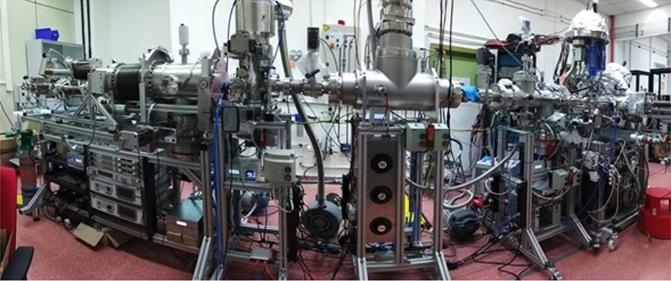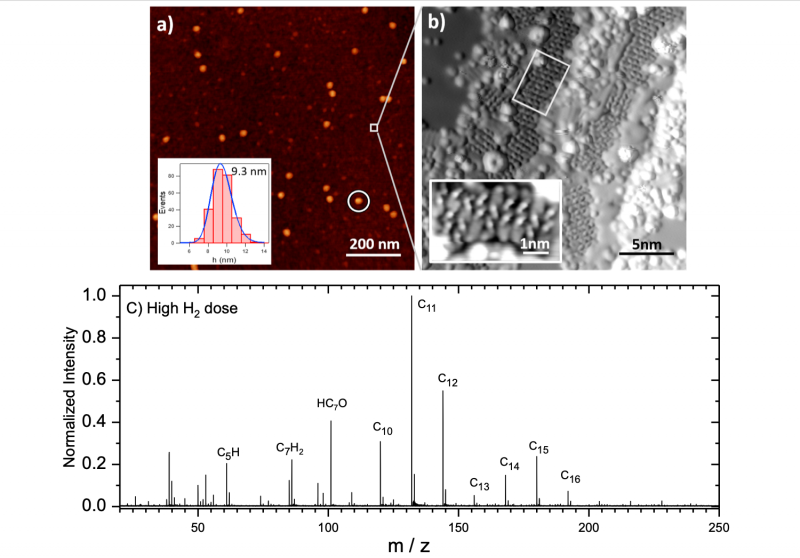News about the formation of star molecules and dust
A research team from Spanish and French laboratories (1) recreated in the laboratory the conditions similar to those involved in the formation of carbonaceous star dust in the environment of the red giants. The experiments conducted show the presence of amorphous carbon nanograins and molecular compounds with very low aromatic content. The question of the formation of hydrogenated aromatic polycyclic molecules, an important component in the physical and chemical evolution of stellar and planetary formation regions, therefore remains open.

The life cycle of stars plays an important role in the complexity of matter. At the end of their life, stars of small to medium masses, such as our Sun, become red giants, ejecting large quantities of relatively hot and dense matter. The new molecules and nanograins formed by this material diluted in the interstellar medium constitute star dust. These are the building blocks for the formation of new stars and planetary systems, as well as a source of ingredients for the emergence of life.
The nature of the nanograins formed today remains very poorly understood. However, this knowledge is necessary to evaluate their role in physico-chemical processes involving energy radiation and interaction with gas that lead to the formation of complex molecules on the surface of these nanograins. Characterizing all these processes is an important branch of activity in astrochemistry and laboratory astrophysics.
The formation of dust in the envelopes of carbon-rich stars (relative to oxygen) was modelled using chemistry in hydrocarbon flames. This results in the formation of hydrogenated aromatic polycyclic molecules (PAHs) such as pyrene and soot particles, both of which are well known on Earth as pollutants. However, PAHs are precisely an important component of astrophysical environments containing more than 10% of the carbon in our Galaxy. It is therefore essential to wonder about their formation. However, carbonaceous dusts are difficult to observe in star envelopes due to the lack of specific spectral signatures.
In order to better understand the nature of star dust, the Nanocosmos project team has built a complex laboratory astrophysics device, the Stardust machine, which allows a more accurate simulation of the physical and chemical conditions in these stars than has been done to date. In particular, it is a question of reconstituting the formation of dust step by step: from the atoms of the photosphere to small molecules (germs) that will trigger the formation of dust. Stardust analogue samples were produced using a mixture of carbon atoms and molecular hydrogen in proportions comparable to those of the red giant envelopes and at a temperature of about 1000 K. They have been characterized with different analytical techniques such as electron microscopy and mass spectrometry.
These analyses revealed the formation of amorphous carbon nanograins and molecules with up to 19 carbon atoms and including aliphatic species but no or very few aromatic species, as suggested by previously established models. Amorphous carbon grains therefore appear to be good candidates for these star dust. On the other hand, the gas phase chemistry involved does not lead to the formation of PAHs, for which other scenarios must therefore be explored. One possibility could be the evolution of aliphatic matter on the surface of these dusts under the effect of ultraviolet radiation that is emitted when the star contracts and becomes a planetary nebula.

Note
(1) Institut de recherche en astrophysique et planétologie (IRAP, Université de Toulouse / CNRS / CNES)
Further Resources
- Scientific paper : Lidia Martínez,Gonzalo Santoro, Pablo Merino, Mario Accolla, Koen Lauwaet, Jesús Sobrado, Hassan Sabbah, Ramón J. Pelaez, Victor J. Herrero, Isabel Tanarro, Marcelino Agúndez, Alberto Martín-Jimenez, Roberto Otero, Gary J. Ellis, Christine Joblin, José Cernicharo and José A. Martín-Gago. Prevalence of non-aromatic carbonaceous molecules in the inner regions of circumstellar envelopes. Nature Astronomy (2019) doi : 10.1038/s41550-019-0899-4
- The ERC Synergy Nanocosmos project funded by the European Research Council is led by two CSIC researchers, José Cernicharo and José Angel Martín-Gago, and a CNRS/University of Toulouse 3 researcher, Christine Joblin. More information on this link.
- Website dedicated to the NanoCosmos project : https://nanocosmos.iff.csic.es/






